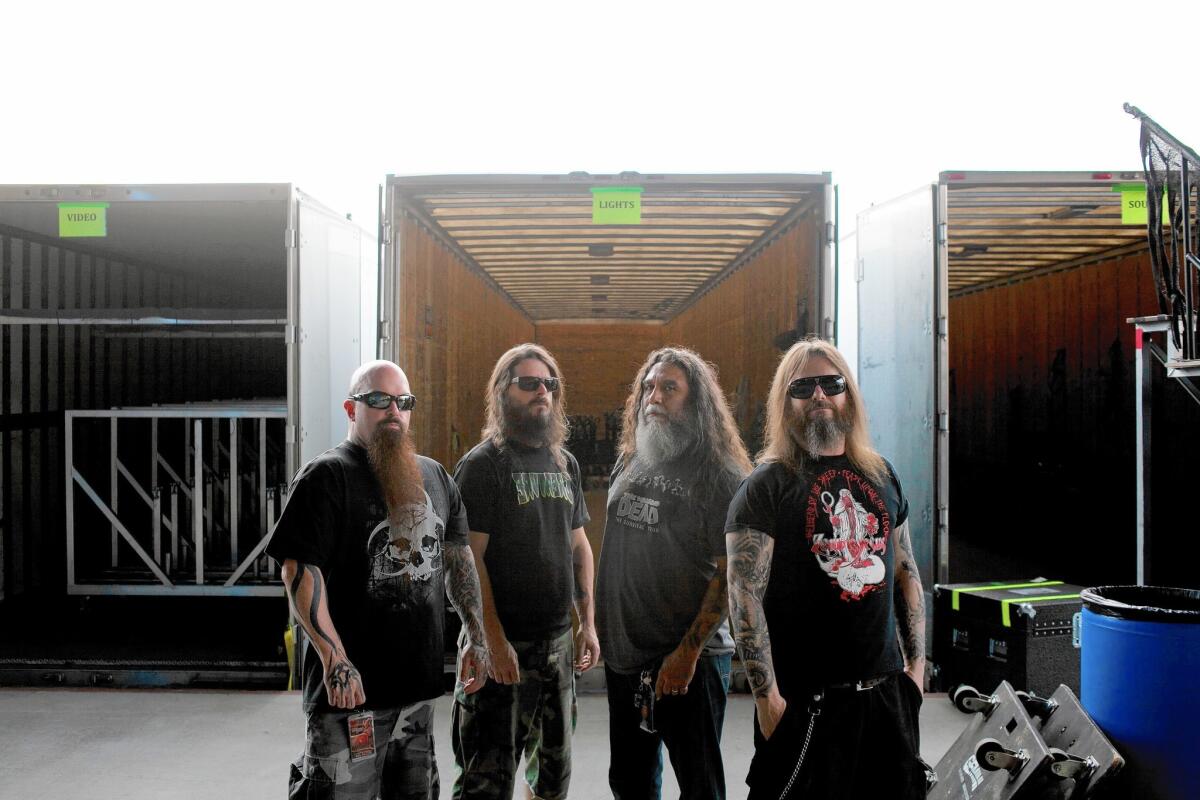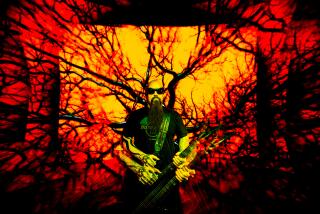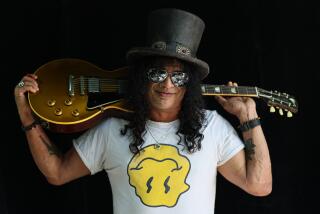Spirit of Jeff Hanneman hovers over Slayer’s new ‘Repentless’ album

Jeff Hanneman was a master of chaos, and it could be heard in the thrash metal tunes he crafted with Slayer.
As half of the band’s speedy dual-guitar attack, he composed or co-wrote of some of Slayer’s darkest, most brooding songs: “Angel of Death,” “Raining Blood,” “Jihad.”
So when Hanneman died two years ago at age 49 from liver failure, even the band wondered if it could go on without him.
“There’s more to a band than just the creative aspect, getting together and making music together,” says singer-bassist Tom Araya, who joined Slayer more than three decades ago. “There’s also your relationship in the band and how we are as partners. That was the part that was more on my mind.”
SIGN UP for the free Essential Arts & Culture newsletter >>
Yet Slayer managed to make “Repentless,” their first album since Hanneman’s passing, and released it this month. In some ways it’s Hanneman’s ongoing presence, more than his absence, that can be felt across the album’s dozen songs. In fact, the record’s title song is a tribute to the late guitarist, describing a life lived without regret or apology:
“My songs relive the atrocities of war / Can’t take society any ... more. Intensity, anarchy, hatred amplified / Playing this ... is all that keeps me alive. I leave it all on the road living on the stage / This is my life where I kill it everyday.”
Now “Repentless” is Slayer’s highest-charting debut , landing at No. 4 on the Billboard Top 200, selling more than 50,000 albums since its Sept. 11 release.
Like Metallica and Anthrax, Slayer was among the originators of an uncompromising assault of noise and attitude called “thrash,” mixing the pace of early punk with the biting flair of the new wave of British heavy metal. Guitarist Kerry King formed the band in Huntington Park with Hanneman, Araya and original drummer Dave Lombardo in 1981.
There was competition among thrash bands then and between Slayer’s two guitarist-songwriters.
“We would keep each other honest,” says King. “If Jeff wrote a riff that I thought wasn’t going to fly, I could tell him. And he would do the same to me. We’d just make up stuff we thought was cool. I’ve called it the search for the ultimate riff. I’m still in quest for the ultimate riff. I don’t know if I’ve found it yet.”
Over the years, that search never led the quartet astray from a purity of sound that shared something of the directness and consistency of Motorhead and the Ramones. The band perfected its approach with the help of producer Rick Rubin, who first suggested eliminating reverb, giving their already brutal metal tunes a cleaver’s edge of immediacy. Lyrics consisted of serial killers, Nazi horrors and the coming war of civilizations. They also attacked religion without mercy, illustrated on the cover of “Repentless” by a Christ figure decaying amid demons and hellfire.
Changes in the band’s sound have generally amounted to a refinement in songwriting and recording technique, never the Slayer formula of unhinged guitars, Araya’s outraged madman screams and drumbeats throttling at a nightmare gallop.
During the band’s summer tour headlining the 2015 Mayhem Festival, that meant the band’s nightly set list could stretch easily from 1985’s angsty “Hell Awaits” to three songs from the new album, as flames erupted around it onstage. Fans expected no less, raising their beers and the devil’s horns or stomping amid the moshing crowds.
“I think that’s one reason we have such loyal fans. We manage to stick to what we do best: being Slayer,” says Araya, his hair still long and dark, but he’s gray-bearded now and somehow more formidable onstage at 54. “We came together and formed the band, and we all knew what we expected from the band. We all knew what Slayer was about.”
NEWSLETTER: Get the day’s top headlines >>
Early work on the new album began in 2011, soon after Hanneman was sidelined by flesh-eating necrotizing fasciitis on his right arm and just as Slayer was about to leave for an Australian tour. Recruited to fill in on guitar on tour was friend Gary Holt of Exodus, another thrash player from the same generation. King decided to begin writing new material because he didn’t know what Hanneman would be able to bring to the next recording project.
“I had to look out for Slayer’s best interest,” explains King, 51, his head shaved and tattooed on the back with a snarling demonic face. “Luckily I did that, because when Jeff passed a couple of years later, had I started writing then, it would have been a gigantic burden. I basically had the luxury of four years to make up this record.”
The years since Slayer’s last album, 2009’s “World Painted Blood,” were difficult even before Hanneman’s illness and death. Araya went through major surgery on his back and neck, abused through decades of intense headbanging. Then Lombardo abruptly left over a financial dispute with the band and its management. Paul Bostaph, who had been in the band and quit twice before, was invited back two years ago.
The drummer knew what he was getting into. “To play with this band is a certain fitness level and energy level and conditioning level,” says Bostaph, 52. “You have to be in it to be on it.”
In the immediate aftermath of Hanneman’s death, Araya made initial comments that suggested Slayer’s future was uncertain. Hanneman had been his closest relationship in the group, a big blond in a hockey jersey, playing custom guitars with his name configured to look like the Heineken beer label. “Me and Kerry got along as partners,” says Araya. “But we disagreed more than me and Jeff. We had to get beyond that hurdle.”
For a time, Hanneman’s condition improved, and he would show up at band rehearsals to work on getting his arm back in shape. But it was never enough for a return to the road for him. Holt was his ongoing fill-in and has remained in Slayer ever since.
“It’s all thrash metal,” says Holt, comparing his work with Slayer and Exodus. “With Slayer I may be going for more chaos at times — a little less melody, a little more maniacal. But I just do what I’ve done since I was a kid: Angus Young on methamphetamines and steroids.”
After fashion model Kendall Jenner (half-sister to Kim Kardashian) was photographed in a Slayer T-shirt and stylishly torn jeans, Holt responded by wearing a “Kill the Kardashians” shirt for the entire Mayhem Fest tour. He fits right in with Slayer.
Hanneman’s final live performance with Slayer was the Big 4 Festival in Indio in 2011, a thrash concert organized by Metallica on the same polo fields that hosted the Coachella Valley Music and Arts Festival just a week earlier. Holt performed most of Slayer’s set, then handed it over to Hanneman for two final songs: “Angel of Death” and “South of Heaven.” They were both tunes from the mid-’80s, when thrash was new and at its most dangerous and alarming.
Hanneman performed with his right arm fully exposed, scarred and ravaged, and raised it high to the 50,000 fans in attendance. It was a dramatic and celebratory moment, and it looked to all like a sign that the guitarist was coming back to his place within Slayer.
“He gave me this huge bear hug, I told him I loved him, he told me he loved me, and he went out and I got to crack a beer and watch,” Holt remembers of that night. “I got to sit there side-stage and see Jeff’s last two songs. Those kind of things aren’t easily forgotten.”
More to Read
The biggest entertainment stories
Get our big stories about Hollywood, film, television, music, arts, culture and more right in your inbox as soon as they publish.
You may occasionally receive promotional content from the Los Angeles Times.











